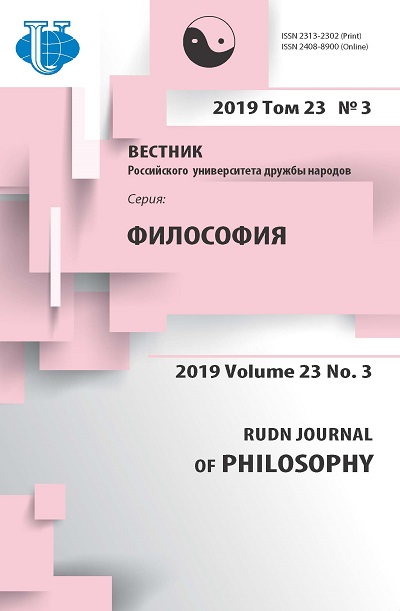THE PRINCIPLE OF THE FINAL SALVATION IN HINDU TANTRIC SOTERIOLOGY
- Authors: Pakhomov SV1
-
Affiliations:
- Herzen State Pedagogical University of Russia
- Issue: Vol 23, No 3 (2019)
- Pages: 278-289
- Section: RELIGIOUS AND SPIRITUAL PRACTICES OF EAST
- URL: https://journals.rudn.ru/philosophy/article/view/21935
- DOI: https://doi.org/10.22363/2313-2302-2019-23-3-278-289
Cite item
Full Text
Abstract
The specificity of tantric soteriology consists of a combination of three basic principles - unity, salvation, and bliss. This article explores the principle of salvation. Spiritual liberation implies the final overcoming of obstacles hindering the new worldview. Unlike the principle of unity, the principle of salvation focuses on difference, not on identity, drawing a sharp line between the desired state of liberation and the present state of dependence. The main obstacles to spiritual liberation are expressed in the well-known triad “avidyā - karma - saṃsāra”. The principle of salvation appears in Tantrism in two interrelated forms, the ascetic and śaktic ones. Both of them agree with each other in rejection of spiritual ignorance. Spiritual ignorance is the main “negative goal”; without deliverance from it there is no freedom. The state of ignorance is existential one and endowed with powerful protective “forces”. The principle of salvation implies the deliverance not only from everything that is usually considered negative (passions, sensual desires, suffering, etc.), but also of “positive” things (virtue). In the śaktic mode of the principle of salvation, it is assumed that an incorrect view of reality is eliminated by a correct view of it. Due to the fact that, according to the tantric adepts, the energies of the divine Śakti act in the world, the understanding of this fact leads the adept to stop perceiving himself as a dependent being even in the midst of an infinite variety of processes and events of the world. Life is then perceived as an unconditioned, spontaneous “divine play”, a stream of divine pleasure. Ascetic form can be reduced to an ontological interpretation of the principle of salvation, and śaktic form to a cognitive one.
Keywords
About the authors
S V Pakhomov
Herzen State Pedagogical University of Russia
Author for correspondence.
Email: sarpa68@mail.ru
кандидат философских наук, доцент кафедры философской антропологии и истории философии Института философии человека
Saint Petersburg, RussiaReferences
- Abhinavagupta. Paramārthasāra (“Essence of the Highest Truth”). Tr. by S Pakhomov. Vestnik Russkoi khristianskoi gumanitarnoi akademii (Newsletter of Russian Christian Academy for the Humanities). St. Petersburg, 2013;14(1):127—139). (In Russ.).
- Abhinavagupta. Tantrāloka. With Commentary “Viveka” by Rajanaka Jayaratha. 12 vols. Vol. I. Ed. by M. R. Śāstrī. Allahabad: Indian Press; 1918.
- Abhinavagupta. Tantrāloka. With Commentary “Viveka” by Rajanaka Jayaratha. 12 vols. Vol. IX. Ed. by MS Kaul. Bombay: Tattva-Vivechaka Press; 1938.
- Abhinavagupta. Parātrīśikа Vivaraṇa. The Secret of Tantric Mysticism. Engl. tr. by J Singh, ed. by B Bäumer. Delhi: Motilal Banarsidass Publishers, 1996.
- Akulavīra-tantra. Kaulajñānanirṇaya and Some Minor Texts of the School of Matsyendranātha. Ed. by PC Bagchi. Calcutta: Metropolitan; 1934. P. 85—106.
- Kaulajñānanirṇaya. Kaulajñānanirṇaya and Some Minor Texts of the School of Matsyendranātha. Ed. by PC Bagchi. Calcutta: Metropolitan; 1934. Р. 1—84.
- Kulārṇava Tantra. Ed. by A Avalon, Tārānātha Vidyāratna. London: Luzac and Co., 1917.
- Lakṣmītantra. Ed. with sanskr. gloss by Paṇḍita Kṛṣṇamacarya. Adyar: Adyar Library and Research Center; 1959.
- Mādhava. Sarvadarśanasaṃgrahaḥ. Ed. by M.M. Vāsudev Śāstri Abhyaṃkar. Mumbai: Nirṇayasāgaramudra; 1924.
- Pūrṇānanda Giri. Śrītattva-cintāmaṇi. Ed. by BM Sāṃkhyatīrtha, etc. Calcutta; 1936.
- Saundaryalaharī with the commentary of Lakṣmīdhara. Maisore; 1959.
- Yoga Bīja. Ed. and tr. by MM Brahmamitra Awasthi. Delhi: Swami Keshananda Yoga Institute; 1985.
- Pakhomov SV. Printsip edinstva v soteriologii induistskogo tantrisma (The unity principle in Hindu Tantric soteriology. Vestnik Russkoi khristianskoi gumanitarnoi akademii (Newsletter of Russian Christian Academy for the Humanities). St. Petersburg, 2019;20(1):205—214. (In Russ.).
- Banerji SC. Tantra in Bengal. Calcutta; 1978.
- Dyczkowski MSG. The Doctrine of Vibration: An Analysis of the Doctrines and Practices of Kashmir Shaivism. Delhi, etc.: Motilal Banarsidass; 1989.
- Dyczkowski MSG. A Journey in the World of the Tantras. New Delhi, Varanasi: Indica Books; 2004.
- Flood G. The Tantric Body. The Secret Tradition of Hindu Religion. London, New York: I.B. Tauri; 2006.
- Gupta S, Hoens D, Goudriaan T. Hindu Tantrism. Leiden, Köln: E. J. Brill; 1979.
- Gupta S. The Pāñcaratra Attitude to Mantra. Understanding Mantras. Ed. by H.P. Alper. Delhi: Motilal Banarsidass, 1991. Р. 224—248.
- Mishra K. Kashmir Śaivism. The Central Philosophy of Tantrism. Delhi: Sri Satguru Publications; 1999.
- Torella R. Introduction. Utpaladeva. Īśvarapratyabhijñākārikā. Vṛtti. Ed. and tr. by R. Torella. Delhi: Motilal Banarsidass Publishers; 2002. P. IX—LIV.
- White DG. The Alchemical Body. Siddha Traditions in Medieval India. New Delhi: Munshiram Manoharlal; 2004.
















